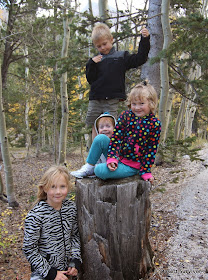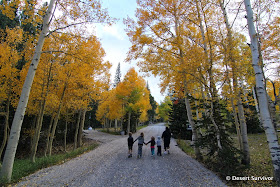Before my husband and I started our big climb, we had time to see just a few things at Mt. Rainier National Park. The entrance with the huge beams is impressive. Then the road continues through massive trees. Once in awhile you can get a peek at the mountain.
Since I knew we would be above treeline for most of our trip, I really wanted some time to savor the huge old trees lower on the slopes. We took a short 0.4 mile hike to some impressive trees.
I liked seeing how these two species had grown together.
My husband spotted a banana slug. This is definitely a creature we don't have around in the desert!
Then we went for a 2.2 mile-round trip to Carter Falls. I was delighted that we got to start our trip on this cool bridge over the Nisqually River.
The water was low in September, I can only imagine how scary it might be to cross in June when the water is a lot higher.
We came across this old wooden pipeline, wrapped in metal. We were clearly walking on an old road, but never found out more about the history of this area. This is part of the 93-mile long Wonderland Trail that circumnavigates the mountain. On our way back down, we found an older man who was hiking it from Longmire to Sunrise. Soon after we found two middle-aged women who were planning on hiking the whole trail, which takes 10-14 days. Only about 200-250 people complete the entire trail each year, which has over 22,000 feet elevation change. That's like climbing Mount Rainier multiple times! These two ladies had climbed the mountain a couple years ago and were now excited to see the park from a different perspective.
A close-up of the old pipe.

It didn't take us long to get to Carter Falls, one of the many waterfalls in the park. I had fun playing with a new filter as I photographed the falls.
After we hiked back to the vehicle, we drove up to Paradise, one of the main attractions of the park due to the wildflower displays. We didn't want to do any hiking here, as we would be on the trail from here up the mountain the next day. Also, some of the trails were closed due to repaving. That led to one lady who arrived to gasp, "It's closed!" She thought the whole mountain was closed and was clearly distraught. Hopefully she noticed people hiking on the detour route.
We checked out the visitor center, which had some rather unsatisfying exhibits hidden away in a corner on the second floor. It was clear that the construction had been done to support the 30-foot snows that occur some winters.
Then we went over to the Paradise Inn. It would have been fun to stay there! We thought we might each lunch there, but they started serving too late for us to make it back to our check-in for our climb.
The lobby had some interesting architecture. We hope to come back here.
We also went over to the Guide Service building. It looked like it had interesting exhibits where maybe we could have learned more about my husband's grandfather and his guiding days, but it was all locked up. The season at Paradise is very, very short, mainly July and August, with some hours in September.
We grabbed a bite in the cafe and then headed back down the mountain. We stopped to take a look at Naruda Falls. Here is the river before it drops.
And here is the marvelous waterfall. (Can you see the bridge at the top? That's where I took the photo from above.) An old interpretive sign about geology had us stymied, but fortunately a newer one helped to explain better that we were seeing a contact zone at the bottom of the falls between volcanic rock of Mount Rainier and other rock (uh, my memory fails me what kind of rock!) of the Tatoosh Range.
We stopped in at the Longmire Museum, where the dated exhibits were much more helpful than the newer ones at Paradise. The kind volunteer at the Museum was also able to answer all our questions.
I had to take a quick photo of this old touring bus. Nowadays traffic is really high on the park roads, necessitating lots of construction to try and keep up (not to mention all the floods that periodically wipe out large portions of roads).
There is so much more to see at Mount Rainier National Park, but we'll have to see it on another trip. It sure is a lot different than the desert, and it's interesting to see how people, animals, and plants adapt to so much more precipitation.


































































